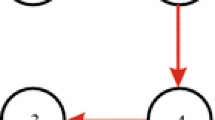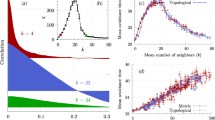Abstract
The emergence of collective decision in swarming systems underscores the central role played by information transmission. Using network-control- and information-theoretic elements applied to a group of topologically interacting agents seeking consensus under switching topologies, the effects of constraints in the information capacity of the communication channel are investigated. This particular system requires us to contend with constantly reconfigurable and spatially embedded interaction networks. We find a sufficient condition on the information data rate guaranteeing the stability of the consensus process in the noiseless case. This result highlights the profound connection with the topological structure of the underlying interaction network, thus having far-reaching implications in the nascent field of swarm robotics. Furthermore, we analyze the more complex case of combined effect of noise and limited data rate. We find that the consensus process is degraded when decreasing the data rate. Moreover, the relationship between critical noise and data rate is found to be in good agreement with information-theoretic predictions. Lastly, we prove that with not-too-large time-delays, our system of topologically interacting agents is stable, provided the underlying interaction network is strongly connected. Using Lyapunov techniques, the maximum allowed time-delay is determined in terms of linear-matrix inequalities.





Similar content being viewed by others
References
Baillieul, J., Antsaklis, P.J.: Control and communication challenges in networked real-time systems. Proc. IEEE 95(1), 9–28 (2007)
Barberis, L., Albano, E.V.: Evidence of a robust universality class in the critical behavior of self-propelled agents: metric versus topological interactions. Phys. Rev. E 89, 012,139 (2014)
Berger, M., Wang, Y.: Bounded semigroups of matrices. Linear Algebra Appl. 166, 21–27 (1992)
Binder, K.: Finite size scaling analysis of ising model block distribution functions. Z. Phys. B Condens. Matter 43, 119–140 (1981)
Bouffanais, R.: Design and Control of Swarm Dynamics. Springer, Heidelberg (2016). https://doi.org/10.1007/978-981-287-751-2
Cai, N., Diao, C., Khan, M.J.: A novel clustering method based on quasi-consensus motions of dynamical multiagent systems. Complexity 2017 (2017). http://downloads.hindawi.com/journals/complexity/2017/4978613.pdf
Cai, N., Xi, J.X., Zhong, Y.S.: Swarm stability of high-order linear time-invariant swarm systems. IET Control Theory Appl. 5(2), 402–408 (2011)
Chamanbaz, M., Mateo, D., Zoss, B.M., Tokić, G., Wilhelm, E., Bouffanais, R., Yue, D.K.P.: Swarm-enabling technology for multi-robot systems. Front. Robot. AI 4, 12 (2017). https://doi.org/10.3389/frobt.2017.00012
Fitch, K., Leonard, N.E.: Information centrality and optimal leader selection in noisy networks. In: IEEE 52nd Conference on Decision and Control (CDC), pp. 7510–7515. IEEE (2013)
Handegard, N.O., Boswell, K.M., Ioannou, C.C., Leblanc, S.P., Tjøstheim, D.B., Couzin, I.D.: The dynamics of coordinated group hunting and collective information transfer among schooling prey. Curr. Biol. 22, 1213–1217 (2012)
Hespanha, J.P., Naghshtabrizi, P., Xu, Y.: A survey of recent results in networked control systems. Proc. IEEE 95(1), 138–162 (2007)
Holme, P., Saramäki, J.: Temporal networks. Phys. Rep. 519, 97–125 (2012)
Horn, R.A., Johnson, C.R.: Matrix Analysis. Cambridge University Press, Cambridge (1987)
Hsieh, M.A., Kumar, V., Chaimowicz, L.: Decentralized controllers for shape generation with robotic swarms. Robotica 26, 691–701 (2008). https://doi.org/10.1017/S0263574708004323
Jadbabaie, A., Lin, J., Morse, A.S.: Coordination of groups of mobile autonomous agents using nearest neighbor rules. IEEE Trans. Autom. Control 48, 988–1001 (2003)
Komareji, M., Bouffanais, R.: Resilience and controllability of dynamic collective behaviors. PLoS One 8, e82,578 (2013). https://doi.org/10.1371/journal.pone.0082578
MacKay, D.: Information Theory, Inference, and Learning Algorithms. Cambridge University Press, Cambridge (2003)
Mateo, D., Kuan, Y.K., Bouffanais, R.: Effect of correlations in swarms on collective response. Sci. Rep. 7, 10,388 (2017). https://doi.org/10.1038/s41598-017-09830-w
Moreau, L.: Stability of multiagent systems with time-dependent communication links. IEEE Trans. Autom. Control 50, 169–182 (2005)
Nair, G.N., Evans, R.J.: Exponential stabilisability of finite-dimensional linear systems with limited date rates. Automatica 39, 585–593 (2003)
Nair, G.N., Fagnani, F., Zampieri, S., Evans, R.J.: Feedback control under data rate constraints: an overview. Proc. IEEE 95(1), 108–137 (2007)
Niculescu, S.I.: Delay Effects on Stability: A Robust Control Approach. Springer, Heidelberg (2001)
Olfati-Saber, R., Fax, J.A., Murray, R.M.: Consensus and cooperation in networked multi-agent systems. Proc. IEEE 95(1), 215–233 (2007)
Papadimitriou, C., Steiglitz, K.: Combinatorial Optimization: Algorithms and Complexity. Chap. 6.1 The Max-Flow, Min-Cut Theorem, pp. 117–120. Dover Publications, New York (1998)
Rakkiyappan, R., Dharani, S., Zhu, Q.: Synchronization of reaction-diffusion neural networks with time-varying delays via stochastic sampled-data controller. Nonlinear Dyn. 79(1), 485–500 (2015)
Ren, W., Beard, R.: Consensus seeking in multiagent systems under dynamically changing interaction topologies. IEEE Trans. Autom. Control 50, 655–661 (2005)
Rubenstein, M., Cornejo, A., Nagpal, R.: Programmable self-assembly in a thousand-robot swarm. Science 345, 795–799 (2014)
Scholz, A., Kuboyama, N., Hempelmann, G., Vogel, W.: Complex blockade of TTX-Resistant Na\(^+\) currents by lidocaine and bupivacaine reduce firing frequency in DRG neurons. J. Neurophysiol. 279, 1746–1754 (1998)
Sekunda, A., Komareji, M., Bouffanais, R.: Interplay between signaling network design and swarm dynamics. Netw. Sci. 4, 244–265 (2016). https://doi.org/10.1017/nws.2016.5
Shang, Y., Bouffanais, R.: Consensus reaching in swarms ruled by a hybrid metric-topological distance. Eur. Phys. J. B 87, 294 (2014). https://doi.org/10.1140/epjb/e2014-50094-4
Shang, Y., Bouffanais, R.: Influence of the number of topologically interacting neighbors on swarm dynamics. Sci. Rep. 4, 4184 (2014). https://doi.org/10.1038/srep04184
Tatikonda, S., Mitter, S.K.: Control under communication constraints. IEEE Trans. Autom. Control 49(7), 1549–1561 (2004)
Vicsek, T., Czirók, A., Ben-Jacob, E., Cohen, I., Shochet, O.: Novel type of phase-transition in a system of self-driven particles. Phys. Rev. Lett. 75, 1226–1229 (1995)
Wong, W.S., Brockett, R.W.: Systems with finite communication bandwidth constraints–part I: estimation problems. IEEE Trans. Autom. Control 42(9), 1294–1299 (1997)
Wong, W.S., Brockett, R.W.: Systems with finite communication bandwidth constraints–part II: Stabilization with limited information feedback. IEEE Trans. Autom. Control 44(5), 1049–1053 (1997)
Xi, J., Fan, Z., Liu, H., Zheng, T.: Guaranteed-cost consensus for multiagent networks with Lipschitz nonlinear dynamics and switching topologies. Int. J. Robust Nonlinear Control (2017). https://doi.org/10.1002/rnc.4051
Young, G.F., Scardovi, L., Cavagna, A., Giardina, I., Leonard, N.E.: Starling flock networks manage uncertainty in consensus at low cost. PLoS Comput. Biol. 9(1), e1002,894 (2013)
Yu, W., Chen, G., Cao, M., Kurths, J.: Second-order consensus for multiagent systems with directed topologies and nonlinear dynamics. IEEE Trans. Syst. Man Cybern. Part B 40, 881–891 (2010)
Zhu, Q., Cao, J.: Stability of markovian jump neural networks with impulse control and time varying delays. Nonlinear Anal. Real World Appl. 13(5), 2259–2270 (2012)
Zhu, Q., Li, X., Yang, X.: Exponential stability for stochastic reaction-diffusion bam neural networks with time-varying and distributed delays. Appl. Math. Comput. 217(13), 6078–6091 (2011)
Zoss, B.M., Mateo, D., Kuan, Y.K., Tokić, G., Chamanbaz, M., Goh, L., Vallegra, F., Bouffanais, R., Yue, D.K.P.: Distributed system of autonomous buoys for scalable deployment and monitoring of large waterbodies. Auton. Robots 42 (2018). https://doi.org/10.1007/s10514-018-9702-0 (in press)
Acknowledgements
This work was supported by a grant from the Singapore National Research Foundation (NRF) under the ASPIRE project, Grant No. NCR-NCR001-040.
Author information
Authors and Affiliations
Corresponding author
Ethics declarations
Conflicts of interest
The authors declare that there is no conflict of interest regarding the publication of this article.
Appendices
Appendices
1.1 Proof of Theorem 2
The following Lemma is instrumental to establish the proof of Theorem 2.
Lemma 2
Consider the following linear system
where \(\mathbf {x}\in \mathbb {R}^N\) is the state variable, \(\mathbf {A}^0\) is a constant matrix and \(\phi (s)\) corresponds to the set of initial conditions considered over the interval \([-\tau ,0]\). The system is asymptotically stable for all values \(\tau \) in the interval \([0,\bar{\tau }]\) if
-
(i)
\(1+\lambda (\mathbf {A}^1(t))\frac{1-e^{s\bar{\tau }}}{s}\not =0\) holds for all \(t\ge 0\), \(s\in \mathbb {C}^+\), and \(\lambda (\mathbf {A}^1(t))\) are the eigenvalues of \(\mathbf {A}^1(t)\);
and
-
(ii)
there exist two positive-definite matrices \((\mathbf {P},\mathbf {Q})\) such that the LMI below holds:
$$\begin{aligned}&\left[ \begin{array}{c}(\mathbf {A}^0+\mathbf {A}^1(t))^T\mathbf {P}+\mathbf {P}(\mathbf {A}^0+\mathbf {A}^1(t))+\bar{\tau }\mathbf {Q}\\ \bullet \end{array}\right. \\&\left. \begin{array}{c}(\mathbf {A}^0+\mathbf {A}^1(t))^T\mathbf {PA}^1\\ -\bar{\tau }\mathbf {Q}\end{array}\right] <0. \end{aligned}$$
Proof
It can be proved as in [22, p. 222] by considering the following Lyapunov candidate
\(\square \)
We now prove the statement of Theorem 2. First, note that all eigenvalues of the matrix \(\mathbf {B}(t)\) are located in the open-right plane given that the interaction network is strongly connected. Therefore \(\mathbf {B}^T(t)\mathbf {P}+\mathbf {PB}(t)\) can be negative definite, and the linear-matrix inequality (24) is feasible for small enough \(\bar{\tau }\). Next, using Lemma 1, stability of the systems (17) or (18) is equivalent to the stability of (20) and (21). By exploiting Lemma 2 with \(\mathbf {A}^0=-\mathbf {I}\) and \(\mathbf {A}^1(t)=\mathbf {B}(t)+\mathbf {I}\), it is observed that the solution of system (20) tends to zero, i.e., \(\lim _{t\rightarrow \infty }\mathbf {x}_1(t)=0\).
Finally, the Laplace transform of (21) yields
where s is a complex variable. The stability of (21) is defined by the denominator of the Laplace transform (\(s+1-e^{-\tau s}=0\)). Letting \(s=\sigma +j\omega \) with \(\sigma ,\omega \in \mathbb {R}\) and \(j^2=-1\), we have
The system (21) is stable for any time-delay \(\tau \), i.e., there exists a \(\mathbf {x}_2^*\) such that \(\lim _{t\rightarrow \infty }\mathbf {x}_2(t)=\mathbf {x}_2^*\) if solution of (25) leads to \(\sigma <0\). We consider the following cases:
-
(i)
\(\sigma =0\Rightarrow \cos (\omega \tau )=e\) which is impossible since \(-1\le \cos (\omega \tau )\le 1\).
-
(ii)
\(\sigma>0\Rightarrow e^{-\sigma \tau }\cos (\omega \tau )=\sigma +1>1\) which is again impossible since \(e^{-\sigma \tau }<1\) and \(-1\le \cos (\omega \tau )\le 1\), then their product cannot be larger than 1.
Therefore, the value of \(\sigma \) obtained from (25) is strictly negative (\(\sigma <0\)) which guarantees the stability of system (21). This concludes our proof.
1.2 Remarks about Theorem and Corollary 1 and Theorem 2
It is worth noting that Theorem 1 and Corollary 1 are based on the Gelfand spectral radius formula and on the construction of the joint spectral radius. The special structure of the matrix \(\tilde{\mathbf {L}}(t)=L(t)/k\), originating from the topologically interacting agents, plays a key role here. These considerations are very different from the result in Ref. [26].
The key challenge in proving Theorem 2 mainly lies in the construction of the LMI and the appropriate application of the Laplace transform. Another key simplification is obtained by means of the coordination transformation in Eq. (19), which simplifies our equation and facilitates the analytical treatment for the time-delay system.
Rights and permissions
About this article
Cite this article
Komareji, M., Shang, Y. & Bouffanais, R. Consensus in topologically interacting swarms under communication constraints and time-delays. Nonlinear Dyn 93, 1287–1300 (2018). https://doi.org/10.1007/s11071-018-4259-1
Received:
Accepted:
Published:
Issue Date:
DOI: https://doi.org/10.1007/s11071-018-4259-1




